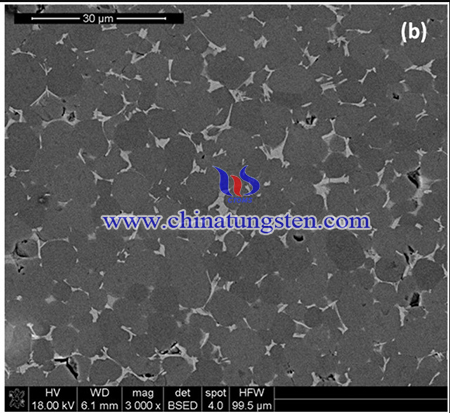Enhanced Electrical Conductivity of BaCeO3-Based Composites By APT
- Details
- Category: Tungsten Information
- Published on Sunday, 06 June 2021 02:29
Materials with perovskite structure are considered as perspective for Solid Oxide Fuel Cells in their standard three-layer system anode/electrolyte/cathode and the innovative construction: symmetrical or single cell. Additionally, application of ceramic proton conductive electrolyte instead of typical for SOFC oxide ion conductive (e.g. yttria-stabilized zirconia, doped ceria) allows to decrease fuel cells working temperature and prevent fuel dilution by reaction products. Thus, perovskite structure ABO3-based materials, mainly BaCeO3 and BaZrO3, seem to be the interesting group for proton conductive fuel cells.

Thus, a method to modify BaCeO3-based material has been achieved by applying ammonium paratungstate as a raw material. The composites with nominal molar composition 0.9BaCe0.9Y0.1O3-0.1BaWO4 were prepared in single step sintering (co-sintering) and via impregnation method. The synthesis method of the BaCeO3-based composites with enhance conductivity is as following steps:
For co-sintering single step solid-state reaction was implemented. Barium carbonate, cerium oxide, water solution of yttrium nitrate (0.28 M) and ammonium paratungstate hydrate were used to obtain the precursors of final compounds. The precursors were calcined at 1200 °C for 24 h in air, then homogenized by crushing in a agate mortar, milled in the absolute alcohol suspension using a rotation-vibration mill with ZrO2 grinding media (Ø = 5 mm) and dried in 90 °C for 24 h. The powder was formed in the pallet die at 2.5 MPa, isostatically pressed at 250 MPa, then sintered at 1600 °C for 3 h in air.

For impregnation method yttrium doped (10% mol) BaCeO3 and BaWO4 powders were synthesized separately by solid-state reaction. Sintered BaCe0.9Y0.1O3 − δ were prepared similarly as described above for co-sintered composite. Barium tungstate was prepared using barium carbonate and ammonium paratungstate (APT) as the precursors by calcination at 1000 °C for 24 h in air, then homogenized by crushing in a agate mortar. The second phase (BaWO4) was introduced to the sintered host material BaCe0.9Y0.1O3 − δ by high temperature impregnation. Sintered bodies of BaCe0.9Y0.1O3 − δ (95% of theoretical density) with the dimensions of 10 mm × 15 mm × 3 mm were placed in the Al2O3 crucible, covered on the top with appropriate amount of BaWO4 powder and heated to 1450 °C to allow melting of barium tungstate. After reaching the temperature samples were kept for 2, 4 and 8 h to allow the penetration of melted BaWO4 into BaCe0.9Y0.1O3 − δ and material impregnation. After impregnation the inner, uniform parts of the samples were taken for further studies.
In summary, BaCeO3-based materials exhibit high electrical conductivity, however undergo degradation in CO2 and H2O containing atmospheres. In this work the BaCe0.9Y0.1O3-BaWO4 composites were prepared by co-sintering and via impregnation methods. The main motivation was to locate the barium tungstate on the grain boundary of Y-doped barium cerate and enhance the functional properties of final material comparing to single phase BaCe0.9Y0.1O3 − δ. It was found that used synthesis procedures lead to two phase materials with doped barium cerate as the main phase and BaWO4 as the second one. The Electrochemical Impedance.
- APT Manufacturer & Supplier, Chinatungsten Online: ammonium-paratungstate.com
- Tungsten News & Prices of China Tungsten Industry Association: www.ctia.com.cn
- Molybdenum News & Price: news.molybdenum.com.cn
- Tel.: 86 592 5129696; Fax: 86 592 5129797; Email: sales@chinatungsten.com



 sales@chinatungsten.com
sales@chinatungsten.com